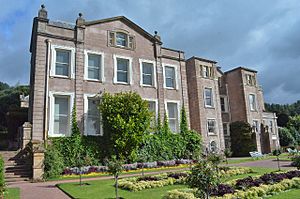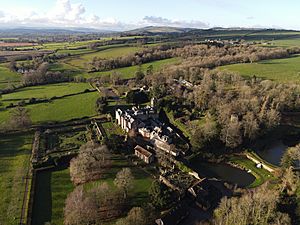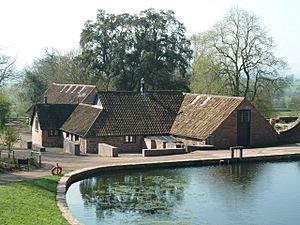Hestercombe House facts for kids
Quick facts for kids Hestercombe House |
|
|---|---|

Hestercombe House
|
|
| Location | West Monkton, Somerset, England |
| Official name: Hestercombe | |
| Designated | 1 June 1984 |
| Reference no. | 1000437 |
|
Listed Building – Grade II*
|
|
| Official name: Hestercombe House | |
| Designated | 17 May 1985 |
| Reference no. | 1060513 |
| Lua error in Module:Location_map at line 420: attempt to index field 'wikibase' (a nil value). | |
Hestercombe House is a very old country house located in West Monkton, near Taunton in Somerset, England. It sits in the beautiful Quantock Hills. The house is officially recognized as a Grade II* listed building, which means it's a very important historic building. Its amazing gardens are also listed as Grade I, making them especially important.
The house was first built in the 1500s. Later, during the Second World War, it was used as a main office for the British Army's 8th Corps. After the war, in 1951, Somerset County Council took over the property. They used it as an office building. Hestercombe House also served as the emergency call centre for the fire service in Somerset until 2012.
Today, Hestercombe House is famous for its beautiful gardens. These gardens have been carefully brought back to how they looked when they were designed by Gertrude Jekyll in the early 1900s. Many people visit the gardens each year. The site is also a special place for nature, especially for Lesser horseshoe bats, which use it as a roosting spot.
Contents
Where is Hestercombe House?
Hestercombe House is found between the villages of West Monkton and Cheddon Fitzpaine. This area is in the south of Somerset, England. It is located on the Quantock Hills, which were the first area in England to be called an "Area of Outstanding Natural Beauty" in 1956. From the gardens, you can see lovely views of the Blackdown Hills.
A Look Back in Time: Hestercombe's History
In the 1000s, Hestercombe was owned by Glastonbury Abbey. Later, in the 1300s, it became part of the La Ware family through marriage. They owned it for nearly 400 years!
The house you see today was built in the 1500s for the Warre family. Over the years, it was passed down through different families. In the 1700s, Coplestone Warre Bampfylde inherited the estate. He was an artist who loved landscapes. He created beautiful "pleasure grounds" north of the house. These grounds included waterfalls, lakes, and interesting garden buildings.
The house was changed and made bigger in the 1700s. But these changes were covered up when the house was updated again around 1875. This was done for Edward Portman, 1st Viscount Portman, who bought the house in 1873.
Hestercombe During World War II
During the early years of the Second World War, Hestercombe House and its gardens were used by the British Army. It became part of the main office for the 8th Corps. This group was in charge of defending Somerset, Devon, Cornwall, and Bristol. The main army office was nearby, but Hestercombe House held the staff who handled people and supplies.
From July 1943 to April 1944, the American army's 398th General Service Engineer Regiment was based at Hestercombe. Even General Dwight D. Eisenhower visited Hestercombe in March 1944 to meet with soldiers.
On March 28, 1944, a German plane crashed near the house. It was shot down by a British plane. After the D-Day landings, Hestercombe became an American hospital centre until the war ended. Many army huts were built at Hestercombe during the war. Most of them were taken down in the 1960s. Only one hut is still standing today.
After the War
The Portman family owned the house until 1944. Then, it was given to the Crown Estate. However, Mrs Portman continued to live there until she passed away in 1951. In 1953, the fire service leased the house.
A visitor centre opened in the old stables in 2005. Most of the money for this came from a special grant. The house was used as the emergency call centre for the fire service until 2012. After the fire service moved out, work began to restore the house.
Today, the house looks like a mix of different styles from the Victorian era. It has an Italian feel, but also parts that look like old Gothic castles. There's even a tower with a glassed-in porch and a French-style roof. The front entrance has a large porch designed in a classic style.
The Watermill and Dynamo House
In the 1700s, a watermill was built at Hestercombe. It used the power of water to run a sawmill, grind corn, and crush apples. There might have been a mill on this spot since the late 1300s.
The large waterwheel was replaced in 1895. At that time, the barn and workshops connected to it were made bigger. The mill then started to make electricity for the estate. This electricity was stored in glass batteries. By the 1980s, the waterwheel was in poor condition.
From the 1950s until 2009, the buildings were used as a barn for farm animals and machines. Since then, it has been restored. It now has a special boiler that uses natural materials for heat. During the restoration, some unusual pipes were found in the floor. The building is now a visitor centre. You can also see the dynamo room, where gas was made from petrol and air to create light.
The Beautiful Gardens
| Site of Special Scientific Interest | |
 |
|
| Area of Search | Somerset |
|---|---|
| Interest | Biological |
| Area | 0.08 hectare (8,600 sq ft) |
| Notification | 2000 |
When Coplestone Warre Bampfylde inherited the house and gardens in the 1700s, he created a Georgian-style landscape garden. This garden had ponds, a big waterfall, a Gothic-style alcove, a Tuscan temple, and a playful "folly" mausoleum. Bampfylde was a talented amateur architect.
Later, in the 1870s, a formal Victorian garden with patterned flowerbeds was added near the house.
The Edwardian Garden: A Famous Design
The Edwardian garden was designed by two very famous people: Gertrude Jekyll and Edwin Lutyens. They worked together between 1904 and 1906. Their design is known for its clear layout and amazing attention to detail. They used different materials like cobbles, tiles, and local stone.
Jekyll and Lutyens were important figures in the Arts and Crafts movement. Gertrude Jekyll was known for her beautiful designs and how she used colours in her gardens, almost like a painter. She was one of the first garden designers to think about the colour, texture, and overall feeling of a garden. Her ideas about using colour were inspired by artists like J. M. W. Turner.
Their teamwork at Hestercombe was very special. A garden writer named Penelope Hobhouse described it like this:
The teamwork between the architect Edwin Lutyens and Gertrude Jekyll taught a whole generation. It was a perfect example of good taste and skill. Their designs for buildings and plants created beautiful works of art. Not many of these original gardens still exist, but their influence can be seen in countless other gardens.
The "Great Plat" is a key part of the garden. It mixes formal patterns with the hardy plants that Miss Jekyll loved. Lutyens also designed the orangery, a special building for growing orange trees, between 1904 and 1909. This building is also a Grade I listed building, as are the garden walls, paths, and steps near the house. The Great Plat has raised terraces with brick water channels on either side. In a TV show, Monty Don suggested that the garden has many features of a traditional Islamic Paradise Garden.
The eastern part of the garden is designed like a Dutch garden. It has plants like tall white Yucca flowers mixed with purple lavender, catmint, and silvery plants.
Since 2003, the Hestercombe Gardens Trust, a charity, has managed the gardens. They received a large grant to restore and protect the site. The gardens have been featured on TV shows. They cover over 100 acres and have three different styles: woodland walks, lakes and ponds, and formal gardens. The Georgian, Victorian, and Edwardian gardens all together create a rich environment for plants and animals.
Bats at Hestercombe
The site is a very important home for Lesser horseshoe bats. They use the roof spaces of an old stable block to have their babies. The number of Lesser Horseshoe bats at Hestercombe is one of the highest in southwest England. Because of this, the site has been named a Special Area of Conservation (SAC), which means it's a protected area for wildlife.
Images for kids










